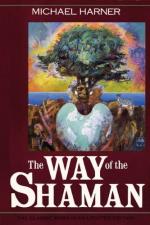
|
| Name: _________________________ | Period: ___________________ |
This test consists of 15 multiple choice questions and 5 short answer questions.
Multiple Choice Questions
1. After a journey that lasts several days in the jungle with his companions, Harner is taken where?
(a) To a ledge overlooking an enchanted valley.
(b) On another journey to experience higher levels of reality.
(c) To the source of the Amazon to meet the highest shaman.
(d) Beneath a waterfall for a mystical experience.
2. While working, why must a shaman remain lightly connected to the material environment?
(a) Because of having to move between realities.
(b) To incorporate the properties of the material world into the cure.
(c) Because of the shaman's physical requirements.
(d) To harness the power of nature.
3. How do shamans use their guardian spirits?
(a) In supplication.
(b) Actively.
(c) In passing.
(d) Through trickery.
4. Shamans pass through what kind of planes?
(a) Parallel.
(b) Earthly.
(c) Cosmological.
(d) Ethereal.
5. What does Harner compare his near-death experience with the Conibo to?
(a) Descriptions in the Bible.
(b) Teachings of Confucius.
(c) Ancient Daoism stories.
(d) The concept of reincarnation.
6. How is a shamanic state of consciousness, or SSC, achieved?
(a) By chanting songs passed down by tribal peoples and drinking fermented coffee.
(b) By drinking nettle tea and fasting for five days.
(c) By entering a trance state and using methods of cosmic geography and nonordinary reality.
(d) By calling upon spirit guides to pull the shaman's spirit out of the body and hurl it to the heavens.
7. Why does Harner include the examples of the Lakota Sioux and Coast Salish tribes for Westerners in particular?
(a) So that they can see that shamanism can be accessed without the use of drugs.
(b) To illustrate the universal nature of shamanism.
(c) To give them examples of shamanism that might be more familiar to them.
(d) Because more than anyone else, Westerners need to understand the nuances of shamanism.
8. Why is the Jivaro shaman who helps Harner worried that the author may not be able to find tsentak?
(a) The tsentak are extremely elusive.
(b) Harner has not gone through the necessary rituals.
(c) Harner is not an Indian.
(d) Finding tsentak is an advanced shamanic practice.
9. What do various cultures report noticing the shaman give off when in a shamanic state of consciousness?
(a) Light in a halo effect.
(b) A highly directional beam of light, like a laser.
(c) Rhythmic sounds.
(d) An unusually sweet aroma.
10. How do the Conibo access the Lowerworld?
(a) Riding on the backs of patagonian capybaras.
(b) Using a giant catahua tree root system.
(c) By chanting and dancing all night in front of a fire.
(d) Through secret holes dug by their ancestors.
11. In a drug-induced vision, Harner sees demons as:
(a) Beetles.
(b) Faceless ghosts.
(c) Fish with teeth.
(d) Reptiles.
12. What is the purpose of rattles used during a shaman's work?
(a) To reinforce drumming for a greater sonic effect.
(b) To ward off evil spirits.
(c) To open up tightly closed portals.
(d) To purify the air surrounding the patient.
13. Why might a shaman work in darkness?
(a) To hide from negative entities.
(b) To conceal his or her expressions.
(c) To achieve the most profound visions.
(d) To minimize interference from the sun's rays.
14. Shaman's do not challenge the validity of someone else's what?
(a) Authentic first-hand experience.
(b) Claims of being a shaman.
(c) Healing methods.
(d) Drug addiction.
15. In "The Way of the Shaman," the author shows similarities between:
(a) Real and fake shamans.
(b) Various shamanic spiritual belief systems.
(c) Once dominant spiritual belief systems.
(d) Younger and older shamans.
Short Answer Questions
1. How does Harner end his first shamanic journey exercise for the reader?
2. What does the author encounter when he drinks maikua?
3. Harner asserts that shamanism has advanced in areas without technological innovations because:
4. What does the author tell an aspiring shaman to do upon returning from his or her first journey?
5. What are guardian spirits known as in Australia?
|
This section contains 692 words (approx. 3 pages at 300 words per page) |

|




